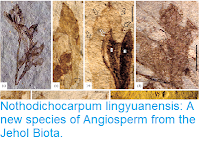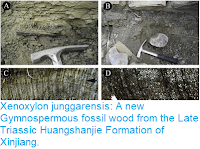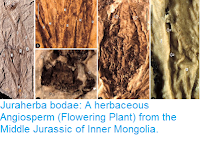Angiosperms (Flowering Plants) underwent a major diversification in the Middle Cretaceous and became ubiquitous members of terrestrial floras from then onwards. However, exactly when large Angiosperm trees first appeared is unclear. The last common ancestor of all living Angiosperms is thought to have been woody, but it is unclear how large it was, and the earliest fossil Angiosperms are all herbaceous. Fossil Angiosperm wood is known in the fossil record from about 113 million years ago onwards, but these fragments are rare and small before about 83.8 million years ago, which has led to speculation that Angiosperm trees were overshadowed by larger Gymnosperms (Conifers etc.) throughout much of the Cretaceous.
In a paper published in the journal Science Advances on 26 September 2018, Nathan Jud of the Department of Biology at William Jewell College, Michael D’Emic of the Department of Biology at Adelphi University, the Burpee Museum of Natural History, and the Department of Anatomical Sciences at Stony Brook University, Scott Williams, also of the Burpee Museum of Natural History, and of the Museum of the Rockies and Department of Earth Sciences at Montana State University, Josh Mathews, again of the Burpee Museum of Natural History, and of the Department of Biological Sciences at Northern Illinois University, Katie Tremaine, once again of the Burpee Museum of Natural History, and of the Museum of the Rockies and Department of Earth Sciences at Montana State University, and Janok Bhattacharya of the School of Geography and Earth Sciences at McMaster University, describe a large Angiosperm Tree trunk from the early Late Cretaceous Ferron Sandstone Member of the Mancos Shale Formation in Utah.
The fossil described takes the form of a silicified log with a preserved length of 11 m and a maximum preserves width of 1.6 m. As this is clearly only the inner part of the log, and the specimen shows no sign of significant taphonomic distortion (swelling of the wood), it is estimated to have had a minimum living diameter of 1.8 m. A tree with a diameter of 1.8 m at breast height would be expected to have a height of somewhat over 50 m, suggesting that this was a canopy tree of significant size. Examination of the wood leads Jud et al. to assign the specimen to the genus Paraphyllanthoxylon, and probably to the species alabamense (they cannot find all of the features diagnostic of this species, but neither can they find any features that rule it out). The Mancos Shale Formation is calculated to be about 92 million years old, suggesting that large Angiosperm Trees had evolved at least 15 million years earlier than previously suggested by the fossil record.
The new angiosperm log in the field. Michael D’Emic in Jud et al. (2018).
The fossil described takes the form of a silicified log with a preserved length of 11 m and a maximum preserves width of 1.6 m. As this is clearly only the inner part of the log, and the specimen shows no sign of significant taphonomic distortion (swelling of the wood), it is estimated to have had a minimum living diameter of 1.8 m. A tree with a diameter of 1.8 m at breast height would be expected to have a height of somewhat over 50 m, suggesting that this was a canopy tree of significant size. Examination of the wood leads Jud et al. to assign the specimen to the genus Paraphyllanthoxylon, and probably to the species alabamense (they cannot find all of the features diagnostic of this species, but neither can they find any features that rule it out). The Mancos Shale Formation is calculated to be about 92 million years old, suggesting that large Angiosperm Trees had evolved at least 15 million years earlier than previously suggested by the fossil record.
Paraphyllanthoxylon cf. alabamense. (A) Photograph of the log in the field. (B) Transverse section (XS) showing diffuse porous wood with vessels in short radial multiples of 2 to 11, growth rings absent, axial parenchyma rare, radial bands of fibers, and rays roughly the same width. (C) Tangential longitudinal section (TLS) showing crowded, hexagonal pits on the vessel wall. (D) TLS showing closely spaced lens-shaped 2- to 4-seriate rays among elongate fibres. (E) Radial longitudinal section showing rows of procumbent and upright ray parenchyma cells. (F) XS showing thin-walled ray cells (at left) and medium thick-walled fibres (at right). Scale bars: 500 μm (B); 100 μm (C); 250 μm (D); 200 μm (E); and 50 μm (F). Michael D’Emic and Nathan Jud in Jud et al. (2018).
Jud et al. also describe several other Plant fossils from the Mancos Shale Formation, though not from the same location, including a number of leaf shoots assigned to the Angiosperm species Elatides curvifolia, and some fragments of Ferns.
Plant compression fossils from the Ferron Sandstone of Utah. (A) Leafy shoot of Elatides curvifolia. (B) Indeterminate angiosperm leaf. (C) Close-up of (A). (D) Isolated Fern pinnule. Scale bars, 5 mm (A) to (C) and 3 mm (D). Nathan Jud in Jud et al. (2018).
Also reported are a number of Vertebrate fossils, also from the Ferron Sandstone of Utah. These include a single Shark tooth, assigned to the Lamniform species Cretodus crassidens, a common species in the Western Interior Seaway during this time, several Crocodyliform teeth, a large Turtle scute, roughly 9 cm in length and 1 cm thick, and part of the sacrum of an Ornithopod Dinosaur.
Vertebrate fossils from the Ferron Sandstone of Utah. (A) Tooth of Cretodus crassidens. (B) Crocodyliform teeth. (C) Dorsal Turtle scute. (D) Ornithopod sacrum. Scott Williams in Jud et al. (2018).
See also...
Follow Sciency Thoughts on Facebook.










